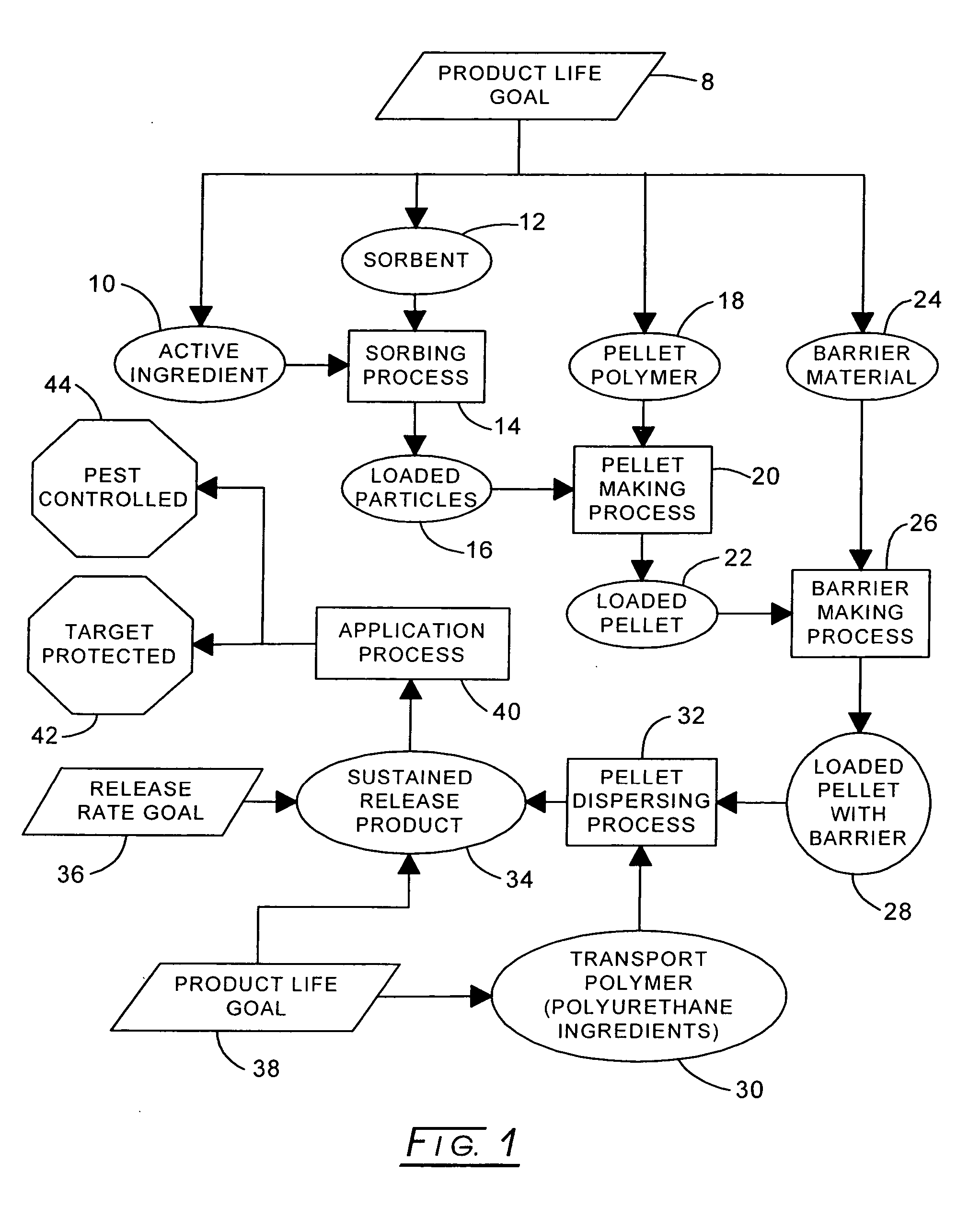Sustained release pest control products and their applications
- Summary
- Abstract
- Description
- Claims
- Application Information
AI Technical Summary
Benefits of technology
Problems solved by technology
Method used
Image
Examples
embodiment # 1
Embodiment #1: Compositions Rich in Polyureas
[0045] The sprayability and longevity needed for some applications of this invention cannot be attained with conventional polyurethane technology in which isocyanates are reacted only with polyols. The polymerization time is too long and the degree of crosslinking is not sufficiently high. In this invention, most or all of the polyol is replaced with amine-containing ingredients. In such cases the transport polymer will predominate in urea groups, rather than urethane groups. Alternatively, thiols could serve as the active hydrogen reactive groups in place of hydroxyl (polyol) groups.
[0046] Thus, one or more isocyanate ingredients such as toluene diisocyanate (TDI), methylene diisocyanate (MDI), polymeric methylene diisocyanate (PMDI), hexamethylene diisocyanate (HDI), or isophorone diisocyanate (IPDI) is reacted with a separate mixture comprising one or more amine-containing ingredients, such as, for example, 4,4′-methylene dianiline, 1...
embodiment # 2
Embodiment #2: Compositions Rich in Aliphatic / Alicyclic Moieties
[0051] Many applications of this invention do not expose the product to sunlight. However, protection of utility poles, wharves, fence posts, and some parts of buildings do expose the product to sunlight that contains significant UV radiation. Products that use MDI, TDI, and other aromatic isocyanates are likely to fail due to photo-oxidation and other free radical-initiated reactions. Aromatic isocyanates absorb UV radiation in the range of 220 nm to 300 nm. Various UV absorbing additives could be used to alleviate this problem, especially if long product life is not a goal. However, longevity is a major goal for the products of this invention. Accordingly, polymer design can be used to increase the UV resistance of the inventive pest species control system.
[0052] Isocyanate Component
[0053] Polyurethanes made from aliphatic and alicyclic isocyanates are known to resist yellowing upon exposure to sunlight because they...
embodiment # 3
Embodiment #3: Pellets for Prolonged Sustained Release of Active Ingredient
[0074] This pest species control system includes the active ingredient(s) incorporated into a sorbent(s), the polymer phase, and the pellet shell (FIG. 1). The active ingredient moves through the pellet, into a matrix of transport polyurethane to the surface of the product where it provides its service. This embodiment focuses on the pellet subsystem. The active ingredient is a pest species control agent as defined above.
[0075] Sorbents (sorbent 12 from FIG. 1) are selected from the ingredients that include, inter alia, silica; carbon; aerogels; oxides of metals; and oxides, carbonates or phosphates of Group 2 metals. The sorbents are selected for their ability to incorporate and release large amounts of active ingredient 10. This implies a large surface area per unit volume. The sorbent also must not cause degradation of the active ingredient to a significant extent.
[0076] Suitable pellet polymers are sele...
PUM
 Login to View More
Login to View More Abstract
Description
Claims
Application Information
 Login to View More
Login to View More - R&D
- Intellectual Property
- Life Sciences
- Materials
- Tech Scout
- Unparalleled Data Quality
- Higher Quality Content
- 60% Fewer Hallucinations
Browse by: Latest US Patents, China's latest patents, Technical Efficacy Thesaurus, Application Domain, Technology Topic, Popular Technical Reports.
© 2025 PatSnap. All rights reserved.Legal|Privacy policy|Modern Slavery Act Transparency Statement|Sitemap|About US| Contact US: help@patsnap.com

